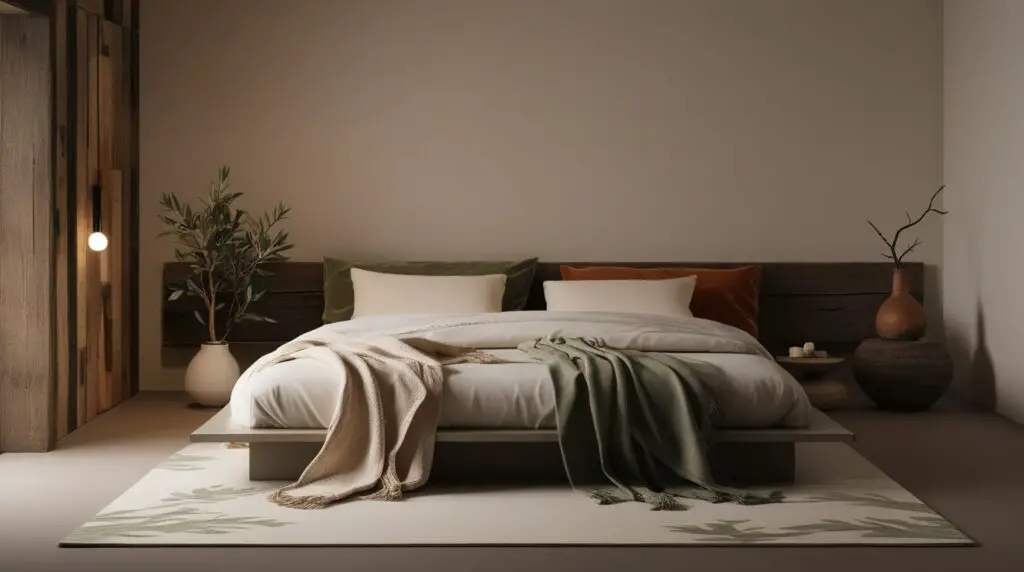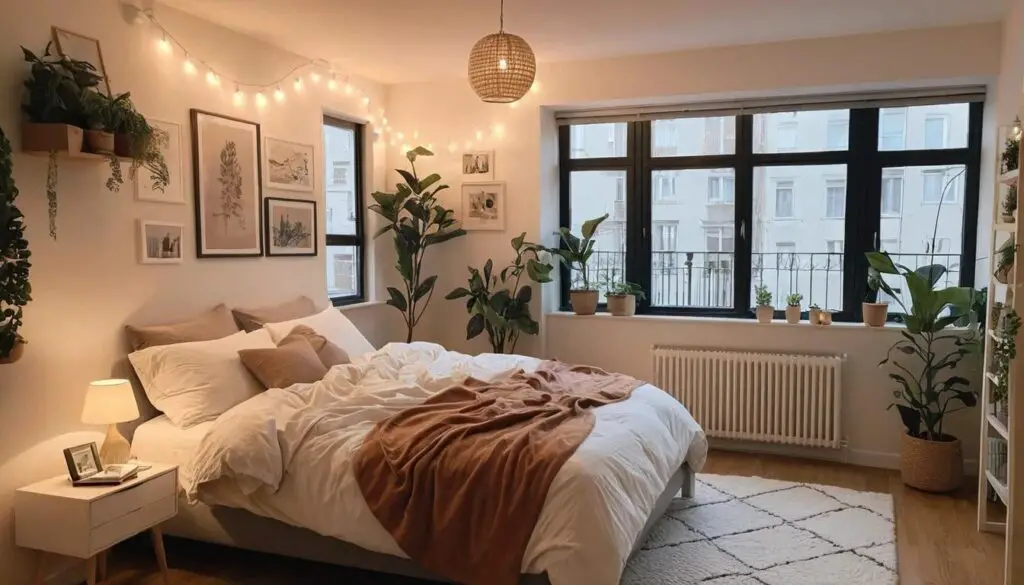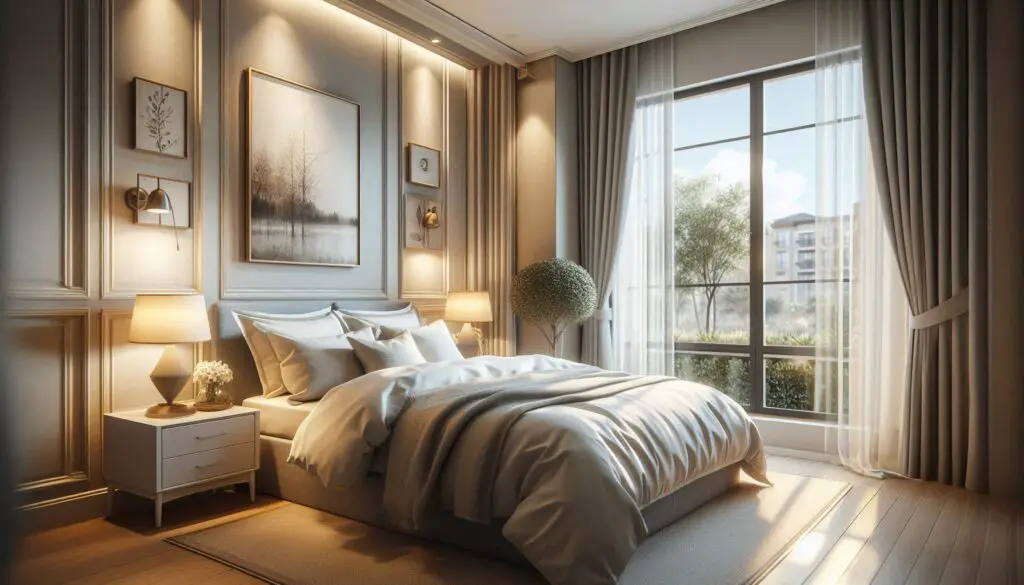The Wabi-Sabi bedroom aesthetic embraces simplicity, imperfection, and natural beauty—creating a peaceful, grounding bedroom that feels like a retreat from the chaos of modern life. This Japanese-inspired philosophy is all about finding beauty in imperfection, appreciating the passage of time, and using natural materials to foster a serene environment. If you love the idea of a space that feels both effortlessly stylish and deeply calming, these 15 Wabi-Sabi bedroom ideas will help you achieve that harmonious balance.
1. Embrace Natural, Earthy Tones
Soft, muted tones inspired by nature are the foundation of a Wabi-Sabi bedroom. Think warm beiges, soft browns, muted grays, and gentle greens—colors that bring a sense of calm and connection to the earth.
How to Make This:
- Choose a neutral wall color like off-white, clay, or light taupe for a warm and grounded feel.
- Incorporate natural textures with linen bedding, cotton throws, or wool rugs.
- Use earthy decor accents like terracotta pots, wooden furniture, or stone sculptures.
- Keep things understated—avoid overly bright colors or bold patterns.
Picture This:
Imagine waking up in a softly lit room where the walls are painted in a soothing, earthy hue. Your linen bedding is effortlessly rumpled, adding to the relaxed, lived-in feel. A handmade ceramic vase sits on your bedside table, holding a single dried flower. The space feels calm, natural, and beautifully imperfect—just like nature intended.
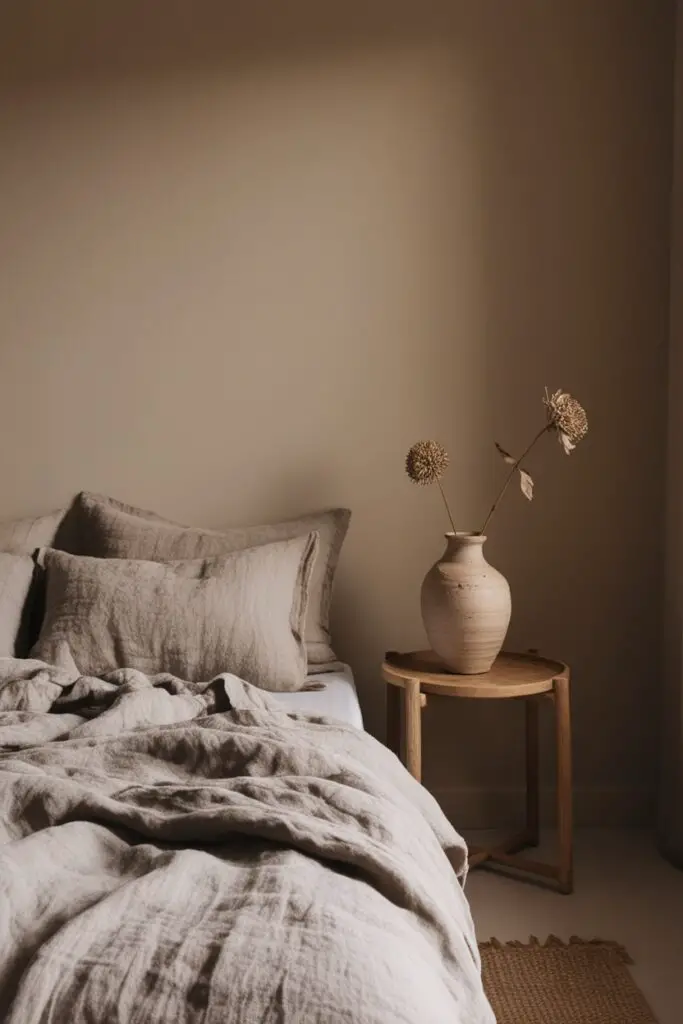
2. Opt for Handmade and Imperfect Decor
Wabi-Sabi is about celebrating imperfection and authenticity—so instead of factory-made, mass-produced decor, look for handmade, one-of-a-kind pieces.
How to Make This:
- Choose hand-thrown pottery or handwoven baskets to display on shelves.
- Incorporate handmade ceramics for bedside trays or candle holders.
- Look for furniture with character—aged wood, reclaimed materials, or naturally uneven edges.
- Display vintage or thrifted finds that tell a story and carry a sense of history.
Picture This:
Your nightstand holds a slightly asymmetrical, handcrafted ceramic mug with warm herbal tea. A rustic wooden shelf displays an old, weathered bowl found at a flea market. Every piece in your space feels personal, telling a unique story of craftsmanship and time.
3. Use Soft, Layered Textiles
Wabi-Sabi interiors focus on comfort and tactility, making layered fabrics and soft textures essential for creating a welcoming, lived-in bedroom.
How to Make This:
- Opt for linen or cotton bedding—both are breathable and develop a softer texture over time.
- Layer with throws and cushions in muted, natural colors like beige, rust, or faded blue.
- Use textured curtains made of muslin or gauze to allow soft, diffused light.
- Add a woven or wool rug for warmth underfoot.
Picture This:
Your bed is draped in soft, crinkled linen, effortlessly styled for a casual yet elegant look. A loosely woven wool throw is casually tossed over the foot of the bed, inviting you to snuggle in. The gentle sway of light cotton curtains in the breeze adds a sense of quiet tranquility to the space.
4. Keep the Decor Minimal, Yet Meaningful
Wabi-Sabi is not about excess or clutter, but rather about curating a space where each item has a purpose and emotional connection.
How to Make This:
- Declutter ruthlessly—only keep objects that are functional or deeply meaningful.
- Choose decor that tells a story, such as a gifted handmade bowl or a vintage clock.
- Limit furniture pieces to only what is necessary—bed, nightstand, dresser, and a cozy chair.
- Embrace open space and let the emptiness be part of the beauty.
Picture This:
Your bedroom feels calm and airy, free from unnecessary clutter. A single wooden stool doubles as a nightstand, holding a simple ceramic lamp and a book. The walls are mostly bare, except for a textured fabric wall hanging. The beauty of the room is in its simplicity and authenticity.
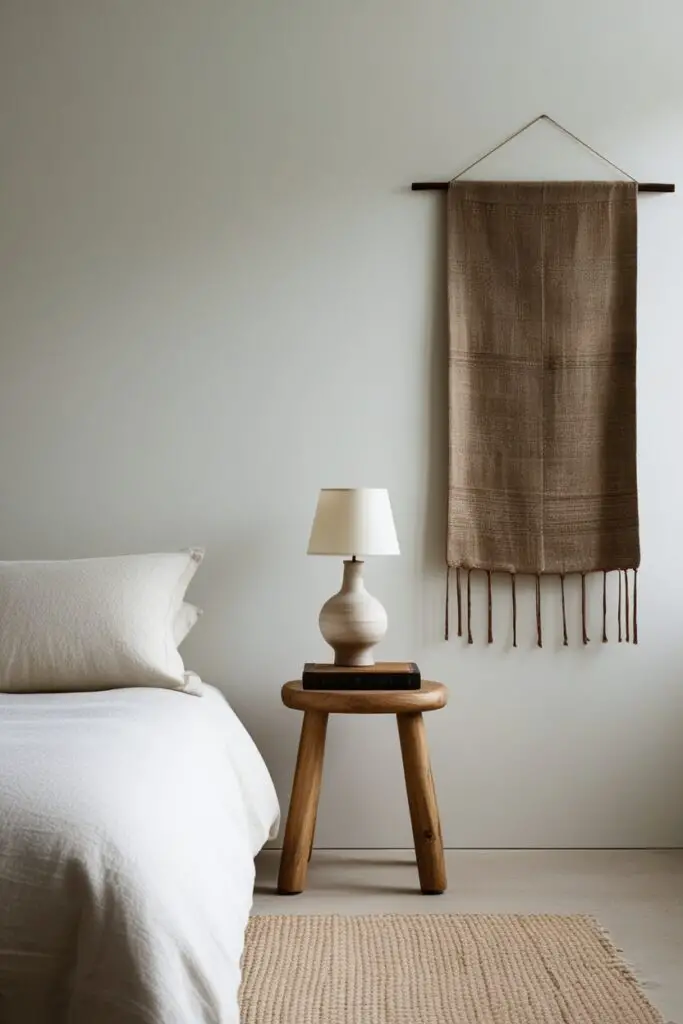
5. Incorporate Raw and Aged Materials
Materials that show their age, texture, and imperfections align perfectly with Wabi-Sabi aesthetics.
How to Make This:
- Use raw wood furniture that highlights natural grain, knots, and imperfections.
- Opt for stone or clay decor to bring in natural elements.
- Incorporate aged metals like brass, copper, or rusted iron in decor or lighting.
- Choose woven baskets for storage instead of plastic bins.
Picture This:
A reclaimed wood bench sits at the foot of your bed, its surface worn with time. A ceramic bowl with tiny cracks rests on your dresser, making it even more beautiful. The natural textures of the space create a cozy, organic retreat where nothing feels forced or artificial.
6. Choose Organic-Shaped Furniture
Forget sleek, perfectly symmetrical furniture—Wabi-Sabi embraces organic, irregular shapes that mimic nature’s flow.
How to Make This:
- Look for live-edge wood furniture that showcases the natural contours of the tree.
- Choose handcrafted nightstands or dressers with subtle imperfections.
- Opt for rounded, asymmetrical mirrors instead of traditional rectangular ones.
- Use curvy or slightly irregular ceramic decor to enhance the organic feel.
Picture This:
Your bedside table is a small, raw-edged wooden stump that brings an earthy charm to the room. A slightly asymmetrical mirror leans against the wall, reflecting the soft glow of a flickering candle. Instead of straight, rigid furniture lines, your space flows naturally with organic shapes that make it feel warm and inviting.
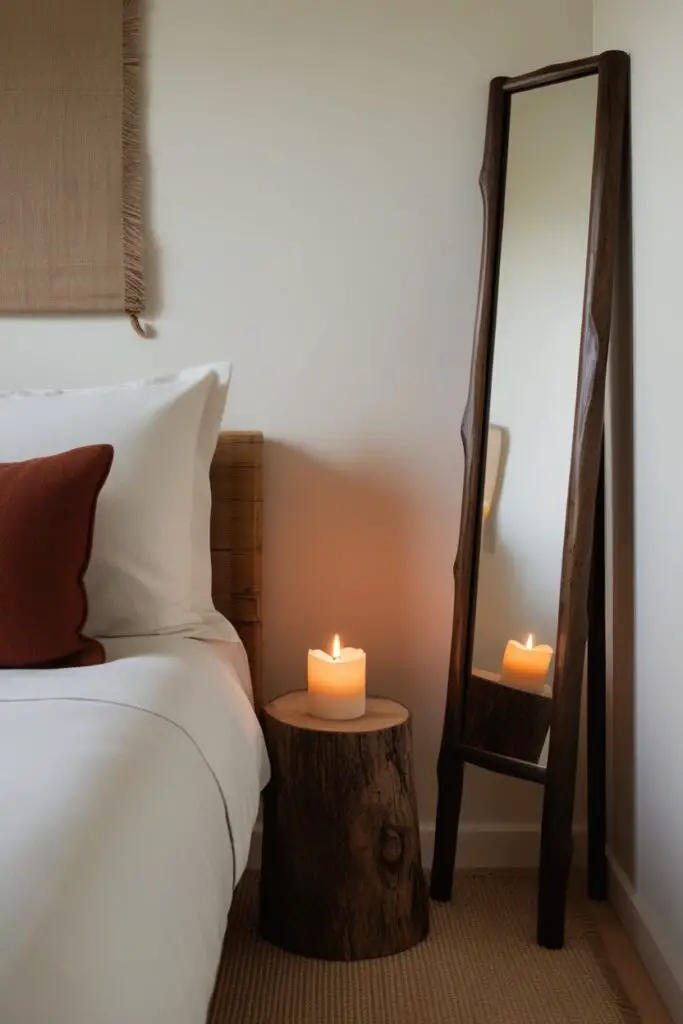
7. Let Nature Be the Decor
A true Wabi-Sabi space welcomes nature inside the home to foster a deeper connection to the earth.
How to Make This:
- Bring in dried branches or foraged greenery instead of artificial plants.
- Display driftwood, pebbles, or natural stones as decor pieces.
- Choose potted plants with a sculptural look, like a bonsai tree or olive plant.
- Use nature-inspired artwork, such as watercolor paintings of landscapes.
Picture This:
A delicate branch, collected on a morning walk, stands elegantly in a ceramic vase on your nightstand. A small potted olive tree adds a hint of greenery in the corner. Instead of artificial, plastic decor, your bedroom is filled with earth’s quiet beauty—living, breathing, and always evolving.
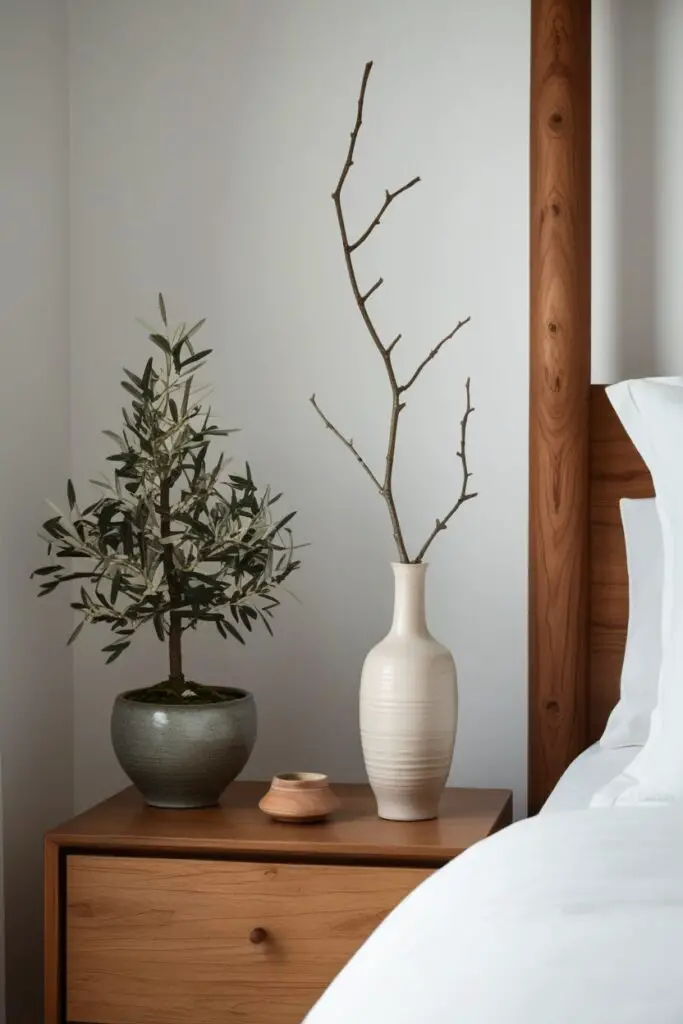
8. Introduce Soft, Ambient Lighting
Bright, artificial lighting disrupts the peaceful Wabi-Sabi atmosphere—instead, opt for soft, natural, and ambient lighting.
How to Make This:
- Use warm-toned LED bulbs rather than harsh white lights.
- Incorporate paper lanterns or linen-covered lamps for a soft glow.
- Place candles in ceramic or glass holders for natural flickering light.
- Use indirect lighting, like floor lamps, sconces, or fairy lights, to create a cozy ambiance.
Picture This:
A soft, warm glow fills the room from a handmade rice paper lantern hanging in the corner. A beeswax candle flickers on the windowsill, casting gentle shadows on the textured walls. The entire space is bathed in tranquility, perfect for unwinding at the end of the day.
9. Use Matted, Weathered, or Distressed Finishes
Instead of polished, ultra-modern surfaces, Wabi-Sabi embraces materials that feel aged, lived-in, and natural.
How to Make This:
- Choose a weathered wooden headboard with visible grain and knots.
- Opt for matte or unfinished furniture over glossy, modern finishes.
- Use limewashed walls or textured paint for a naturally aged look.
- Incorporate vintage textiles like an old wool blanket or handwoven rug.
Picture This:
Your bedside dresser has a slightly faded, distressed look, making it feel like it has a history. The walls have a soft, textured plaster finish, adding depth and warmth. Everything in the room carries a sense of time and character, embracing the beauty of imperfection.
10. Emphasize Negative Space
Less is more in a Wabi-Sabi bedroom—open space is just as important as decor.
How to Make This:
- Avoid overfilling your bedroom with furniture—keep only what you need.
- Let empty walls breathe instead of covering them with excess artwork.
- Use open shelving sparingly, displaying only a few meaningful items.
- Position furniture mindfully to create an uncluttered flow.
Picture This:
A simple bed with crumpled linen sheets sits in the center of the room, with only a wooden stool and a single ceramic lamp beside it. The walls are mostly bare, allowing light and shadow to play across their surface. The space feels open, calming, and uncluttered, making it a true sanctuary.
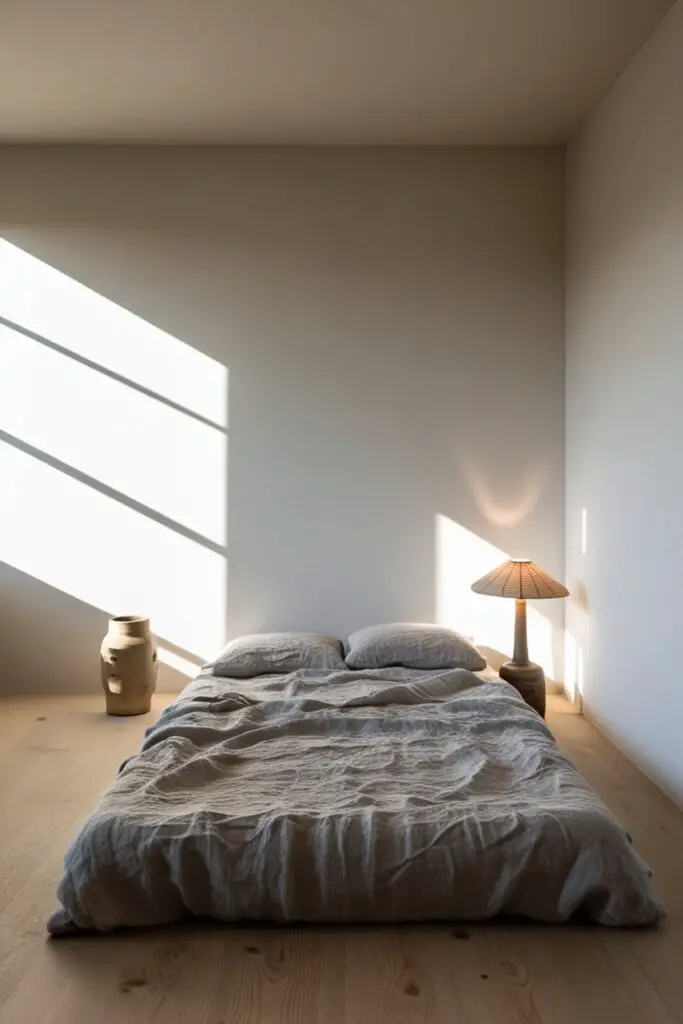
11. Create an Imperfectly Made Bed
Forget the idea of a neatly tucked-in bed—Wabi-Sabi beds are effortlessly unmade, yet inviting.
How to Make This:
- Use soft, natural linen bedding that looks better when slightly wrinkled.
- Layer different textures—a wool blanket over linen sheets, for example.
- Drape throws casually instead of folding them perfectly.
- Use oversized pillows that add to the cozy, unstructured feel.
Picture This:
Your bed is casually rumpled, inviting you to sink into its soft layers. A loosely draped wool blanket spills over the edge, adding to the effortless charm. The entire setup feels lived-in and real, rather than staged and overly curated.
12. Use Reclaimed and Repurposed Materials
Sustainability and Wabi-Sabi go hand in hand—choosing reclaimed materials adds history and character.
How to Make This:
- Opt for a reclaimed wood bed frame with a weathered finish.
- Use vintage crates or old suitcases as storage solutions.
- Turn an old wooden ladder into a blanket rack.
- Choose second-hand or antique decor that has a story behind it.
Picture This:
An old wooden trunk serves as both a nightstand and storage for extra blankets. The headboard is made from repurposed barn wood, its knots and cracks only adding to the charm. Every piece in the room carries a sense of history and soul.
13. Display Imperfect, Handmade Artwork
Art in a Wabi-Sabi bedroom should feel personal, textured, and imperfect—not mass-produced.
How to Make This:
- Hang a hand-painted canvas with visible brushstrokes.
- Frame a simple ink drawing or charcoal sketch.
- Use abstract, muted tones instead of bright colors.
- Lean artwork against the wall instead of mounting it perfectly.
Picture This:
A softly textured hand-painted canvas leans against the wall, its neutral brushstrokes blending seamlessly with the space. A charcoal sketch of a single leaf hangs nearby, its simple lines evoking quiet elegance.
14. Decorate with Worn Books and Textured Paper
Books and handmade paper add a poetic, nostalgic touch to a Wabi-Sabi bedroom.
How to Make This:
- Stack vintage books with worn covers on a bedside table.
- Display open books with poetic passages as decor.
- Hang handmade paper or calligraphy art on the wall.
- Choose natural paper journals for writing reflections.
Picture This:
A stack of old, faded books sits on the floor beside the bed, their pages softly yellowed with time. A handmade Japanese paper scroll hangs on the wall, carrying a single, poetic phrase.
15. Incorporate a Sense of Ritual
A Wabi-Sabi bedroom should encourage moments of stillness and peace.
How to Make This:
- Create a small meditation or reading nook.
- Use an incense burner or essential oil diffuser for calming scents.
- Keep a gratitude journal beside the bed for nightly reflections.
- Designate a space for quiet morning rituals.
Picture This:
A simple ceramic bowl holds dried lavender, filling the air with a subtle scent. A journal rests beside a hand-poured candle, inviting you to unwind with a few thoughtful words before sleep. Your bedroom is more than just a space—it’s a retreat for the soul.
Conclusion
Creating a Wabi-Sabi bedroom is about embracing imperfection, finding beauty in the simple, and curating a space that feels grounding and serene here are stylish bedroom design to help you create that. By using natural materials, soft textures, aged decor, and intentional minimalism, you can transform your bedroom into a sanctuary of peace and authenticity. 🌿✨

